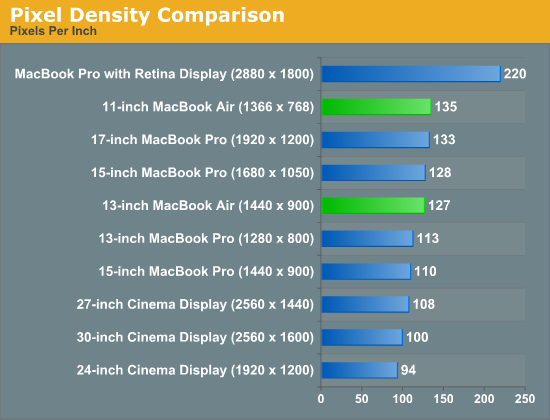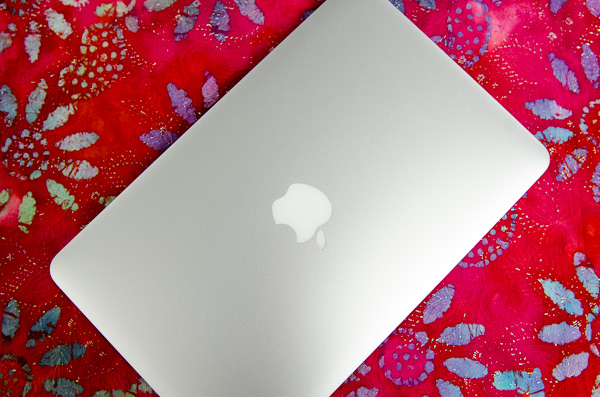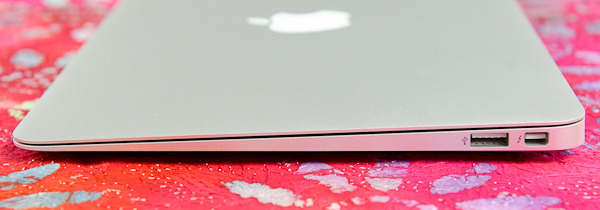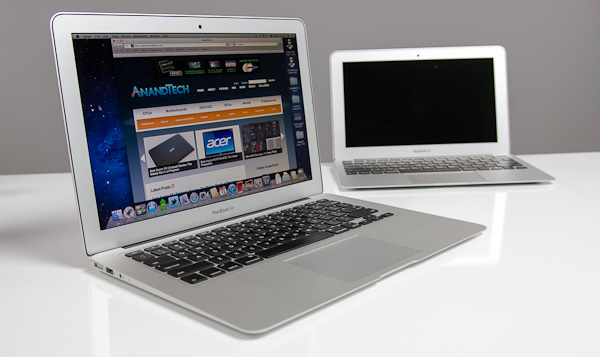The 2012 MacBook Air (11 & 13-inch) Review
by Anand Lal Shimpi on July 16, 2012 12:53 PM EST- Posted in
- Apple
- Mac
- MacBook Air
- Laptops
- Notebooks
Things are getting very blurry.
The MacBook Pro once stood for tons of power plus upgradability. Add a Retina Display and now it's just tons of power. It's a thicker, faster MacBook Air (with an awesome display). It's not bad, in fact it's quite amazing, but it confuses the general order of things.
The MacBook Air doesn't help in the clarity department. You can now order a MacBook Air with up to 8GB of RAM and a 512GB SSD, for the first time in MacBook Air history. Users who were once forced into Pro territory because of RAM and storage requirements can now happily live with an Air. And thanks to Turbo Boost, you do get similar performance in lightly threaded workloads.
Take a step away from the Mac world and you'll see the rest of the market is going through its own confusing period. Nearly every single Microsoft partner is mixing tablets and Ultrabooks. If your tablet uses smartphone hardware, and can dock into a notebook or Thunderbolt itself into a desktop, is all of this a lot of confusion before client computing moves entirely to smartphones? NVIDIA said it would happen publicly (even Intel did so privately a few years ago). Maybe it wasn't just convenient rhetoric. Maybe that's where we're headed. Until then, there are going to be a lot of different form factors, all with very compelling features. The MacBook Air continues to be one of them.
Despite the recent Ultrabook frenzy, the MacBook Air was one of the first (if not the first) to marry performance with usability, screen size/resolution, portability and battery life. Ultraportables prior to the MacBook Air's arrival in 2008 typically sacrificed in one or more of the above areas. I spent years in pursuit of the perfect ultraportable in college over a decade ago (30 is the new 20 right?), and generally came away disappointed and empty handed.
In 2010 Apple changed the expectations of cost with the MacBook Air. The new 11-inch model would start at just $999. And the 13-inch would only cost $300 more. The very first MacBook Air, by comparison, retailed for $1800. Apple took an ultraportable and made it its mainstream notebook. It was a bold move but one that was very forward looking.
Today the MacBook Air is even more affordable. The 11-inch model still starts at $999, but the 13-inch version is only $200 more. From the outside not a lot has changed, but that doesn't mean there's any less to talk about. Ivy Bridge, USB 3.0 and faster SSDs are all on the menu this year. Let's get to it.
The 11 & 13
Unlike the other thin member of Apple's Mac lineup, the MacBook Air chassis hasn't changed over the past three years. Since the 2010 update that gave us the 11-inch model and significantly lower prices, Apple has stuck with a design that only recently has seen widespread emulation.
While our last review focused on the beginning of a new generation, this review takes a look at a very mature, yet still very good design. The MacBook Air is just so pleasant to carry around. It'll make even the new rMBP feel like a pig.
Both the 11 and 13-inch models are effortless to carry around. While I dread traveling with a traditional notebook, slipping one of these into my backpack is barely noticeable. You can get used to and take for granted just about anything, but the form factor of the MacBook Air continues to be a favorite of mine even today.

The 11-inch MacBook Air is a great option for those who want the portability of a tablet but find themselves wanting to attach a keyboard to it most of the time. The 11.6-inch display boasts the highest pixel density of all of Apple's non-retina displays at 1366 x 768, but it's still quite usable. You don't make any sacrifices on keyboard size or key spacing (it's identical to the 13-inch model for the majority of the keys), nor do you have to give up any performance either. Apple offers all of the same CPU, memory and storage upgrades across both MacBook Airs. And with no discrete GPU, thermal throttling isn't really a problem either in the 11-inch chassis. With Thunderbolt, the 11-inch MacBook Air can actually give you the best of both worlds: an incredibly portable computer when you're on the go, and enough to act as your desktop when docked to a Thunderbolt Display.
I've traditionally always bought the 11-inch MacBook Air with the thought that I'd carry it when I didn't need to lug around my MacBook Pro. I seemed to be fooling myself however as over 90% of the time I'd end up with the MacBook Pro. The 11-inch Air was relegated to typewriter duty when I needed a change of scenery while writing at home. It's a great writer's companion, but if I couldn't have more than one system I'd have to opt for its bigger brother.
When I first reviewed the redesigned 13-inch MacBook Air I wrote that it felt more like a normal notebook, while the 11 was something a bit more unique. Perhaps I was more infatuated with the new 11 at the time, because these days I'm more drawn to the 13-inch MacBook Air as the notebook to have if you can only have one.
You get a 23.5% increase in screen resolution on a display that's just easier to look at. While 1440 x 900 is a bit much on a 15-inch MacBook Pro, I'd say it's near perfect on the 13-inch Air. If Apple were to do the Retina treatment on here, it'd be magnificent.
The larger chassis allows room for an SD card reader, which is thankfully quite functional. Otherwise the port layout is identical to the 11-inch model.
| 2012 MacBook Air Lineup | ||||||
| 11.6-inch | 11.6-inch (high-end) | 13.3-inch | 13.3-inch (high-end) | |||
| Dimensions |
H: 0.11-0.68" (0.3-1.7cm) W: 11.8" (30cm) D: 7.56" (19.2cm) |
H: 0.11-0.68" (0.3-1.7cm) W: 12.8" (32.5cm) D: 8.94" (22.7cm) |
||||
| Weight | 2.38 lbs (1.08kg) | 2.96 lbs (1.35kg) | ||||
| Cores/Threads | 1.7GHz dual-core Core i5 | 1.8GHz dual-core Core i5 | ||||
| Base Clock Speed | Intel HD 4000 | |||||
| RAM | 4GB DDR3L-1600 | |||||
| SSD | 64GB SSD | 128GB SSD | 128GB SSD | 256GB SSD | ||
| Display Resolution | 1366 x 768 | 1440 x 900 | ||||
| Ports | Thunderbolt, 2x USB 3.0, headphone jack | Thunderbolt, 2x USB 3.0, SD card slot, headphone jack | ||||
| Price | $999 | $1099 | $1199 | $1499 | ||
In its role as a proponent of simplicity, Apple has reduced the decision between what Air to get down to screen size, resolution and battery life (the 13-inch chassis houses a much larger battery). If you like having more of all of those things, the 13-inch Air is for you. If carrying anything larger than a tablet upsets you, buy the 11.




















190 Comments
View All Comments
Osamede - Tuesday, July 17, 2012 - link
This Y5 was highly portable. If you never used one you have no idea. It was wedge shaped. And the shape allowed for durablity. It was military grade and rated to survive a drop of several feet. And yes STILL only 3.5 lbs, In 2004.Besides its now 2012, give us a call when Apple manages to bring to market a 14" laptop with optical drive at 3.5 lbs.. Only God knows the kind of hype we would have heard it it was Apple doing what Panasonic managed damn near a decade ag.
There was also the even smaller Panasonic W series and before that Sharp had some really good products with the Actius series at really good prices. And now thats going back to probably 1998 or even earlier
Of course Apple fanboys imagine that the world began when Apple launched the MacBook Air. Pschew.....
KPOM - Tuesday, July 17, 2012 - link
Apple isn't going to make any more notebooks with optical drives. Once the classic MacBook Pro is phased out, optical drives are history at Apple. If you notice, most Ultrabooks lack them, as well.A wedge design topping out at 1.9" thick is still pretty bulky. Obviously it was designed for a niche audience, since they aren't selling them anymore. From the specs in 2007 it had a Core Duo 1.66GHz, topped out at 1.5GB RAM, and was very expensive. The keyboard also looks cramped.
http://www.trustedreviews.com/Panasonic-ToughBook-...
I'm not disputing that there were ultraportables before the MacBook Air. Heck, I've even pointed to the PowerBook Duo. I've always been a fan of ultraportables and though they were a long-neglected category. Apple itself didn't have one for 2 years after the 12" Powerbook was dropped.
Most ultraportables were slow sellers that were quietly abandoned. To its credit, Apple stuck with the MacBook Air. A lot of Apple fans were even calling for Apple to drop the MacBook Air as late as September 2010. However, they stuck with it and continued to perfect the design. It's indisputable that the release of the $999 11.6" MacBook Air in October 2010 launched the concept of a mainstream ultraportable.
Osamede - Friday, July 20, 2012 - link
Nice try with the red herring about optical drive.The Panasonic was 3.5 lbs with Optical dive. Take that weight out and you have a 14" laptop with 1400 x 1050 at 3.2 lbs.....in 2006.
And yet according to you we are all supposed to roll over in supplication because in 2012 Apple is selling 13" laptops that weight 3lbs. Spare me the hype. Even The 2010 Sony Z is already a superior laptop compared to even todays "latest" MacBook Air, let alone the 7 year old Panasonic model.
Some of you swallow marketing BS and think it is fact.
KPOM - Friday, July 20, 2012 - link
Red herring? You are the one claiming that Apple should be putting in optical drives if they want to brag. My point is that optical drives are mostly passé. Intel hasn't made it part of the Ultrabook standard. Sony's Vaio Z is an impressive machine, but at more than twice the cost of the base MacBook Air it had better be.I'm not saying we need to roll over in supplication. What I am saying is that Apple transformed the ultraportable from a niche device to a mainstream device. My whole point, which your red herring about Panasonic Toughbooks and Sony Vaios ignores, is that ultraportables had been around for a decade but weren't popular devices until Apple got the formula right. Maybe Panasonic could have made a 14" laptop with 1400x1050 at 3.2lbs in 2006, but they didn't. Maybe Sony could have made a $999 Sony Vaio in 2010, but they didn't. Apple DID make a $999 MacBook Air in 2010. Apple DID make an ultraportable with a full size keyboard and super slick trackpad in 2008, and they DID make it affordable in 2010, and they DID take the drastic step of dropping hard drives and going exclusively with SSD storage in 2010.
phillyry - Tuesday, March 26, 2013 - link
You can't just say that this other laptop was lighter than it actually was because it would be lighter if it didn't have an optical drive that it did have. Confused much? That's because it doesn't make sense. Your logic is flawed. It either had the drive and the weight and bulk that go with it (as it did) or it didn't (as in your imaginary best case).phillyry - Tuesday, March 26, 2013 - link
Also, Apple is phasing out the optical drive. No red herring there.KPOM - Tuesday, July 17, 2012 - link
"Of course Apple fanboys imagine that the world began when Apple launched the MacBook Air. Pschew..... "Actually a lot of "Apple fanboys" HATED the original MacBook Air.
Read some of the comments to this article: http://www.macworld.com/article/1131583/macbookair...
As for optical drives, it's 2012. Did you complain when Apple stopped supporting the floppy drive, too? I don't see any optical drives on Microsoft's Surface Pro.
phillyry - Tuesday, March 26, 2013 - link
The devices you refer to were not mainstream.will54 - Monday, July 16, 2012 - link
"While 1440 x 900 is a bit much on a 15-inch MacBook Pro, I'd say it's near perfect on the 13-inch Air. If Apple were to do the Retina treatment on here, it'd be magnificent." This line is a bit confusing, can you explain further?Tegeril - Tuesday, July 17, 2012 - link
I assume he intended to mean that the 15" screen is too large for 1440x900 as the pixels are quite large, but on a 13" screen it is ideal.